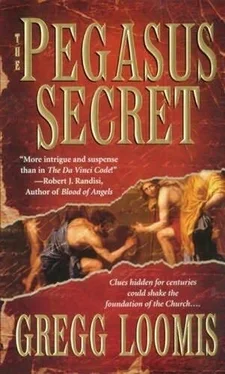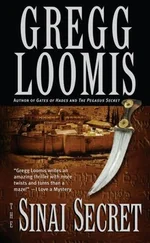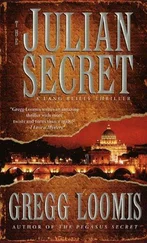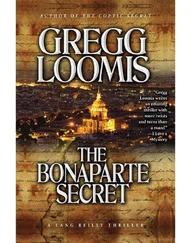Standing on tiptoe to bring his eyes even with the stone shoulders, Lang sighted down the damaged arm. It was aimed at a hill somewhat taller than the others. Even from the poor detail of the map, Lang figured he was looking at Cardou, the slope on which Pietro had made his discovery.
Was the statue a clue or just one more roadside shrine?
Lang walked back to the cross. Although shorter than the statue, its elevation made the top higher than Christ's head. From a few feet further up the slope, Lang could line up cross and statue like front and rear gunsights. The place on Cardou, the target, was indistinguishable from the surrounding slopes, nothing but white limestone with a scattering of trees tenaciously rooted in the rocky soil.
With his hiker's compass Lang noted he was facing a heading of about seventy-five degrees, a little north of due east. Trying to keep the compass as balanced as possible, he walked around to the front of the cross and squinted closely at the blurred date. It could possibly have been 1838.
Or it could have been the mathematical equivalent of the word puzzle in the picture.
1838
8-1=7
8-3=5
Seventy-five. Seventy-five degrees.
Compass heading or just a date? A few days ago, a week ago, Lang would have seen -no encrypted message in a date on a cross. But then, he would never have thought about paintings as maps or Latin anagrams, either.
Magnetic north, of course, was not only different from true north but it also moved a little every few years.
Seventy-five degrees in Saunière's time might not be the same exact heading today. Also, every compass had its own unique, built-in, degree of error. Without the correction card that came with the compasses on ships and aircraft, there was no way to know how far off the instrument might be. Or that it might not be off at all.
Returning to the car, Lang picked up the camera and took a number of shots lining the cross and statue up against the backdrop of Cardou.
Then he drove down a steep descent, crossed the Aude just past the point at which the Sals branched off, and turned almost due east. To his left he could see a silhouette dark against the afternoon sun, a tower of Blanchefort on its white pinnacle.
Seeing the old castle was a lot easier than getting there. Twice he took white dirt roads which headed towards the top of the mountain but turned out to be disappointing. One ended in a barnyard, leaving him staring at a pigsty with the occupants staring right back. The second was more devious. It headed straight for the old Templar fort, waiting until it dipped over a rise to make a right-angle turn and intercept the same road that had led him not to the castle but to pork.
Lang remembered something Dawn used to say, that a man would drive to hell before he would stop and ask directions, to which Lang retorted that the last man to ask directions was one of the Wise Men who asked King Herod where the Christ child had been born. The inquiry had a less than salutary effect on a lot of local infants and men haven't asked directions since. Herod notwithstanding, Lang would have inquired if he could have found someone to ask.
The third time was indeed the charm.
No matter how slowly Lang drove, white dust billowed behind the car like a chute behind a dragster. When he stopped to look at the woefully inadequate map, a capricious wind blew the choking, stinging cloud into the Peugeot's open windows. By the time he was pretty well covered with dust, the road became little more than a path and its grade increased enough to provoke mechanical protests from the car's already underpowered engine. The path became a track and the track ended at a level spot a hundred yards or so from the summit.
Lang parked and got out, making sure the Peugeot was in gear and the brakes on. If it took off on an excursion of its own, he was in for a long walk. There were a number of tire tracks in the loose soil but they were rounded, washed out or abraded by the wind, not recent. He began climbing the steep slope to the old fortress, each step sending a cascade of loose dirt and pebbles racing downhill.
Only the single tower he had seen from below crowned the top of the hill, its white stones reaching maybe a hundred feet before ending in steel scaffolding that had a head start on rusting away. Someone's restoration,project had been abandoned long ago.
Lang was disappointed.
He had expected more than this, at least some indication where the walls and buildings had stood. Deep down, at that place where all men are part little boy, imagination had pictured a well-maintained cloister behind a huge portcullis. Perhaps a few men in armor, maybe Pietro himself.
Instead, he saw stones scattered where they had been pulled down, probably by the locals as material was needed for their own buildings. Rock already quarried and shaped was far too valuable to ignore. The tower, or what was left of it, had been preserved because it would have been difficult to get to the huge stones at the top and pry them loose. Judging from the accumulation of lime splotches, used condoms and graffiti, the inside of the tower had served birds, lovers and political satirists equally:
Lang smiled at the thought of Pietro and his brethren's reaction to the frenzied fornication that had obviously taken place here.
Steps worn by centuries of feet were carved into the stone of the tower's inner wall, each smaller than Lang's size tens. At one time, the structure had several stories, as indicated by the square holes cut into the stone that would have held floor joists.
Lang turned his eyes back to watch where he was going. A misstep would have unfortunate consequences.
The deck or floor at the top had also long disappeared. The stairs simply ended four or five feet below the crenellated battlements. Lang leaned against the cool stone for support as he turned and surveyed three hundred sixty degrees.
To his left rear he could see the red tiles of Rennes-le- Château's few buildings. In front and slightly east of north was the town the map described as Serres.
Rennes and Serres.
Pietro had been right: militarily, Blanchefort had not been in a position to defend either. A force sent from here would have had to cross a river, all too easily guarded by a hostile army. Rennes, now Rennes-le-Château, was distant, too far to see what might be happening there. The first notice of an attack to any defender at Blanchefort would have been smoke from a town already sacked and burning.
If not to defend Serres and Rennes, what purpose had this old fortress served?
Cardou was close and in full view. Lang couldn't be certain, but he thought he was looking at the same face of the mountain he had lined up with the cross and statue. From here, he was much closer and could see a spot a couple of hundred yards square where the hillside leveled briefly. It was wide enough to have collected piles of white scree.
Balanced with one hand against the wall of the tower, Lang took the camera out and shot another series of pictures. It was difficult to exchange the compass for the camera while steadying himself, but he managed without doing more than giving himself a good scare when his hand slipped a few inches. Seventy-five degrees again. Accurate or not, the magnetic needle was telling him the cross, statue and tower all lined up to point to the same place on Cardou's slopes.
He had to back down the steps. There was no room to turn around.
The shadow of the tower had grown substantially. There was not going to be enough daylight left to explore Cardou. Lang gave the slope one more glance and got back into the Peugeot.
Cardou
1649 hours
It was only when the diminutive Peugeot disappeared downhill that the sniper lowered the weapon. It was the first time the telescopic crosshairs and the blunt, flash suppressed muzzle had been off Lang since he had emerged from the tower.
Читать дальше












